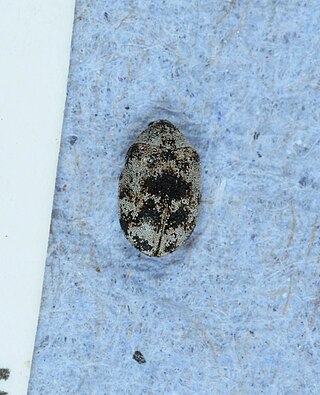
Anthrenus thoracicus is a species of carpet beetle that is present in United States, including such states as: Arkansas, Illinois, Minnesota, Mississippi, Missouri, Montana, Oklahoma, Pennsylvania, South Carolina, Texas.

Anthrenus sophonisba is a species of carpet beetle in the family Dermestidae. It is known from United States.

Anthrenus (Solskinus) sogdianus is a species of carpet beetle in the family Dermestidae. It is present in Central Asia. Based on current records, the species is known to inhabit mountainous regions situated from west to north of lake Issyk-Kul in Kyrgyzstan.

Anthrenus fucosus is a species of carpet beetle in the family Dermestidae present in United States.

Anthrenodes is a subgenus of the genus Anthrenus of the subfamily Megatominae within the family of skin beetles. Subgenus is distinguished by antennae with 10 segments.

Anthrenops is a subgenus of the genus Anthrenus of the subfamily Megatominae within the family of skin beetles. Subgenus is distinguished by antennae with 9 segments.
Ranthenus is a subgenus of the genus Anthrenus of the subfamily Megatominae within the family of skin beetles. Species of subgenus are present only in Asia and Turkey. Subgenus is distinguished by antennae with 4 segments.

Helocerus is a subgenus of the genus Anthrenus of the subfamily Megatominae within the family of skin beetles. Subgenus is distinguished by antennae with 5 segments.

Peacockia is a subgenus of the genus Anthrenus of the subfamily Megatominae within the family of skin beetles. Only one African species is currently described.

Solskinus is a subgenus of the genus Anthrenus of the subfamily Megatominae within the family of skin beetles. Subgenus is distinguished by antennae with 7 segments.

Florilinus is a subgenus of the genus Anthrenus of the subfamily Megatominae within the family of skin beetles. Subgenus is distinguished by antennae with 8 segments.

Anthrenus is a subgenus of the genus Anthrenus of the subfamily Megatominae within the family of skin beetles.

Anthrenus malkini is a species of carpet beetle in the subgenus Anthrenodes of the genus Anthrenus, family Dermestidae. It is known from Oman, Qatar, Saudi Arabia, United Arab Emirates, and Yemen.

Anthrenus angustefasciatus is a species of carpet beetle in the subgenus Anthrenus of the genus Anthrenus, family Dermestidae. It is known from Europe, Turkey, Algeria, Morocco, and Tunisia.

Anthrenus blanci is a species of carpet beetle in the subgenus Florilinus of the genus Anthrenus, family Dermestidae. It is known from Canada and the United States.

Anthrenus chiton is a species of carpet beetle in the subgenus Anthrenus of the genus Anthrenus, family Dermestidae. It is known from the United States.

Anthrenus umbra is a species of carpet beetle in the subgenus Anthrenus of the genus Anthrenus, family Dermestidae. It is known from Mexico (Sonora) and the United States (Arizona).

Anthrenus pulaskii is a species of carpet beetle in the subgenus Anthrenus of the genus Anthrenus, family Dermestidae. It is known from the United States (California).

Anthrenus pimpinellae complex is a group of closely related species from subgenus Anthrenus. Most species that currently belong to the group were previously assigned as subspecies of Anthrenus pimpinellae.

Anthrenus olgae is a species of carpet beetle in the subgenus Florilinus of the genus Anthrenus, family Dermestidae. It is known from Europe in countries such as Austria, Bulgaria, Cyprus, Czech Republic, United Kingdom, Finland, Germany, Hungary, Latvia, Montenegro, Netherlands, Poland, Russia, Slovakia, Sweden and Ukraine. It has been introduced to Canada.




















